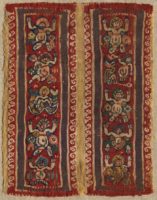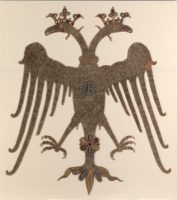Fragment, Sleeve Ornament of a Tunic, Period: Early Byzantine, circa: 5th – 7th century. Made in: Egypt. Materials: tabby weave with inwoven tapestry ornament, linen and wool. Overall: 15.6 x 20 cm (6 1/8 x 7 13/16 in.). The Cleveland Art Museum Hours: Tuesdays, Thursdays, Saturdays, Sundays 10:00 a.m.–5:00 p.m. Wednesdays, Fridays 10:00 a.m.–9:00 p.m. Closed Mondays.
Fragment of a Tunic, Period: Middle Byzantine circa: first half of 7th century, Made in: Egypt. Materials: tabby weave with inwoven tapestry ornament, linen and wool. Overall: 26.1 x 74.3 cm (10 1/4 x 29 1/4 in.). The Cleveland Art Museum Hours: Tuesdays, Thursdays, Saturdays, Sundays 10:00 a.m.–5:00 p.m. Wednesdays, Fridays 10:00 a.m.–9:00 p.m. Closed Mondays.
Altar Cloth or Podea. Period: Late Byzantine, circa: late 14th century. Made in: probably Greece or Constantinople. Materials: Silk, embroidery. Dimensions: 58 1/2 x 51 1/8 in. (148.6 x 129.9 cm).
Museum Description: “The double-headed eagle became the primary symbol of the state during the late Byzantine centuries and was also adopted for liturgical use. This huge eagle was probably used as an altar cloth or as a podea, a skirt hung beneath an icon. The inscription, which connects the owner with distinguished imperial dynasties, exaggerated the claims of a pretender to the patriarchal throne.”
On view at The Met Fifth Avenue in Gallery 303. The Metropolitan Museum of Art (New York) is one of the world’s largest and finest art museums. Its collection includes more than two million works of art spanning five thousand years of world culture, from prehistory to the present and from every part of the globe. Public Hours: 10:30 a.m.–5:30 p.m. Open seven days a week.
Veil Embroidered with Gold Thread. Period: Late Byzantine; circa: end of the 13th or beginning of the 14th c. A liturgical article used for covering sacred vessels on an altar. It depicts Jesus in a portrayal of the Communion of the Apostles, symbolic of the sacrament of Holy Communion. One of the rare extant Byzantine embroideries. Made in: Constantinople. Dimensions: 0.52×0.65 m.





